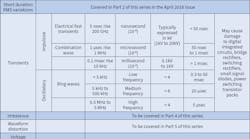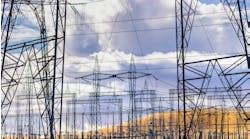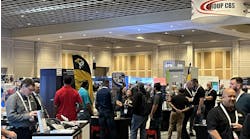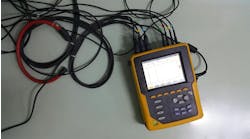This article is Part 3 of a seven-part series on the effects of power quality disturbances on a five-stage electronic LED driver. Stemming from Part 1, which ran in the April 2018 issue, Part 2 (in the May 2018 issue) dealt with short-duration RMS voltage variations (interruptions, sags, swells). Now let’s focus on the most important disturbance category impacting electronic LED drivers: transients. An old term used in the early days of electrical engineering, a “transient” is an undesirable electrical event that is momentary in nature. Transients occur in AC and DC systems in the voltage and current. All transients are conducted electrical power quality phenomena.
Power systems and power quality engineers always use an adjective before transient to describe the specific transient being discussed, such as voltage transient and current transient — general descriptions of voltages and currents that have transients embedded in their waveforms. The Table provides the category breakdown and all technical specifications for the transients discussed above.
Impulsive transient — a sudden nonpower frequency change in the steady-state condition of voltage or current that is unidirectional in polarity (primarily either positive or negative) is the definition published in the IEEE 1159-2009.
Damped oscillatory transients (also known as “ring waves”), according to IEC 61000-4-12 (2017): Electromagnetic Compatibility (EMC) – Part 4-12: Testing and measurement techniques – Ring wave immunity test, are non-repetitive damped oscillatory transients occurring in low-voltage power, control, and signal lines supplied by public and non-public networks. Ring waves can also be repetitive damped oscillatory waves occurring mainly in power, control, and signal cables installed in high-voltage (HV) and medium-voltage (MV) stations. Ring waves fall into the oscillatory transient’s category with having a spectral content of less than 500 kHz.
The impulsive transient’s category includes three secondary categories: nanosecond (nsec) on the order of 10-9 seconds, microsecond (µsec) on the order of 10-6 seconds, and millisecond (msec) on the order of 10-3 seconds. The well-known combination waves, first defined in the IEEE Standard 587-1980 – IEEE Guide for Surge Voltages in Low-Voltage AC Power Circuits, are unidirectional surges caused by overvoltages from lightning strikes and the switching of electromechanical devices in power systems.
Ring waves and combination waves never exceed one-half period (10 msec for 50-Hz systems and 8.33 msec for 60-Hz systems) of the normal mains (power frequency) waveform (at 50 Hz or 60 Hz) in duration. These surges (or transients) can occur from AC line (also known as the Hot or L1 conductor) to AC neutral (also known as N) to the AC ground conductor (or G). They can be periodic or random. Their amplitudes, durations, or rates (of change) may cause malfunction (operational upset) and damage (latent or permanent), causing failure of electrical and electronic equipment.
Before determining if a surge (or transient) should be considered as a surge voltage or surge current, discussion on the sources (i.e., where these electrical phenomena originate) is needed. Surges, which occur in a low-voltage (less than 1,000V) AC power circuit, whether the circuit is part of an electric utility power distribution system (and some parts of this system are less than 1,000V) or is part of a customer’s facility power system (i.e., residential, commercial, or industrial), develop from two major sources: lightning and switching. Lightning surges may strike one or multiple conductors (or another metallic part) of a power system (utility or customer), to a structure of interest, to any nearby structure and any part of the Earth’s surface (e.g., soil, rocks, sand, etc.). This surge phenomena can induce voltage surges into any indoor or outdoor circuit. Moreover, the lightning strikes or flashes we see far off in the distance are distant lightning and can also cause equipment damage and failure. Some of the voltage surges occurring in any indoor or outdoor circuits can be induced by distant lightning.
Direct lightning strikes to a building or structure (indoor or outdoor) will cause significant noticeable damage to LED drivers. The front-end AC network is the most susceptible part of the driver. This includes the AC line fuse, surge protective device (SPD), electromagnetic interference (EMI) filter components, and bridge rectifier (discrete and packs).
Intentional actions, resulting from mechanical and electromechanical switching on the power system (utility and customer), occur because capacitors banks are switched (manually or automatically) on to or out of a utility- or customer-owned power system circuit and cause switching surges. Utility and customer loads turned on or off (manually or automatically) also cause switching surges. A metal object (e.g., falling pole), a tree or limb and another power line are examples of unintentional events that cause power system faults, also resulting in switching surges. Corrective actions on the part of the electric utility or customer to resolve these problems or to restore power to an electric utility or customer circuit will also cause switching surges.
Switching surges seem to be the most troublesome transient threat to today’s electronic LED drivers. The unfortunate part of this problem is that all facilities have switching devices that generate switching surges. The expertise in the power quality investigation lies in the ability to strategically locate one or more power quality monitors (see EC&M article https://bit.ly/2xUngK8), common sense and some important facts about the building, its loads, and customer’s business to determine which sources are causing the problem. Adding additional surge or transient protection with a “wait and see” approach has no underlying engineering plan and usually isn’t cost effective.
Most of today’s buildings and property sites contain both power systems and communication systems, which can produce surge voltages. These surge voltages are multiple-system interaction overvoltages. It only takes one surge current flowing in one of these systems to cause an overvoltage (or surge). Such a disturbance can cause malfunction and failure of multi-port electronic equipment. Almost all LED drivers are multi-port devices. Multi-port drivers have an AC input power port, a set of 10V twisted-pair dimming leads, or a more sophisticated communications port for dimming and driver control. Some drivers also have a third conductor paired with the AC input conductors for driver control. The presence of each port increases the driver’s exposure to malfunction and failure caused by transients. Exposure of multi-port drivers to transients in the electromagnetic environments of buildings is a growing problem which needs immediate attention before the next wave of driver failures starts to occur.
Let’s look at some real-world examples of transient-laden electrical disturbances (Fig. 1A and 1B). As a power quality community, we know that arcing faults are common on distribution and transmission feeders. These types of faults are typically caused by lightning strikes to the circuit, tree limbs contacting the circuit, or animals contacting the circuit. Arcing faults often contain a significant third harmonic component. Consequently, the arcing voltage waveform often has a “flat-top” appearance, resembling a square-wave. The arcing current typically exhibits a continuous ringing that can be attributed to the ringing between the system inductance and capacitance as the voltage changes suddenly as occurs with the step change of a square-wave.
Keebler is a senior power quality engineer and power systems consultant at Electrotek Concepts, Inc. in Knoxville, Tenn. He can be reached at [email protected].





